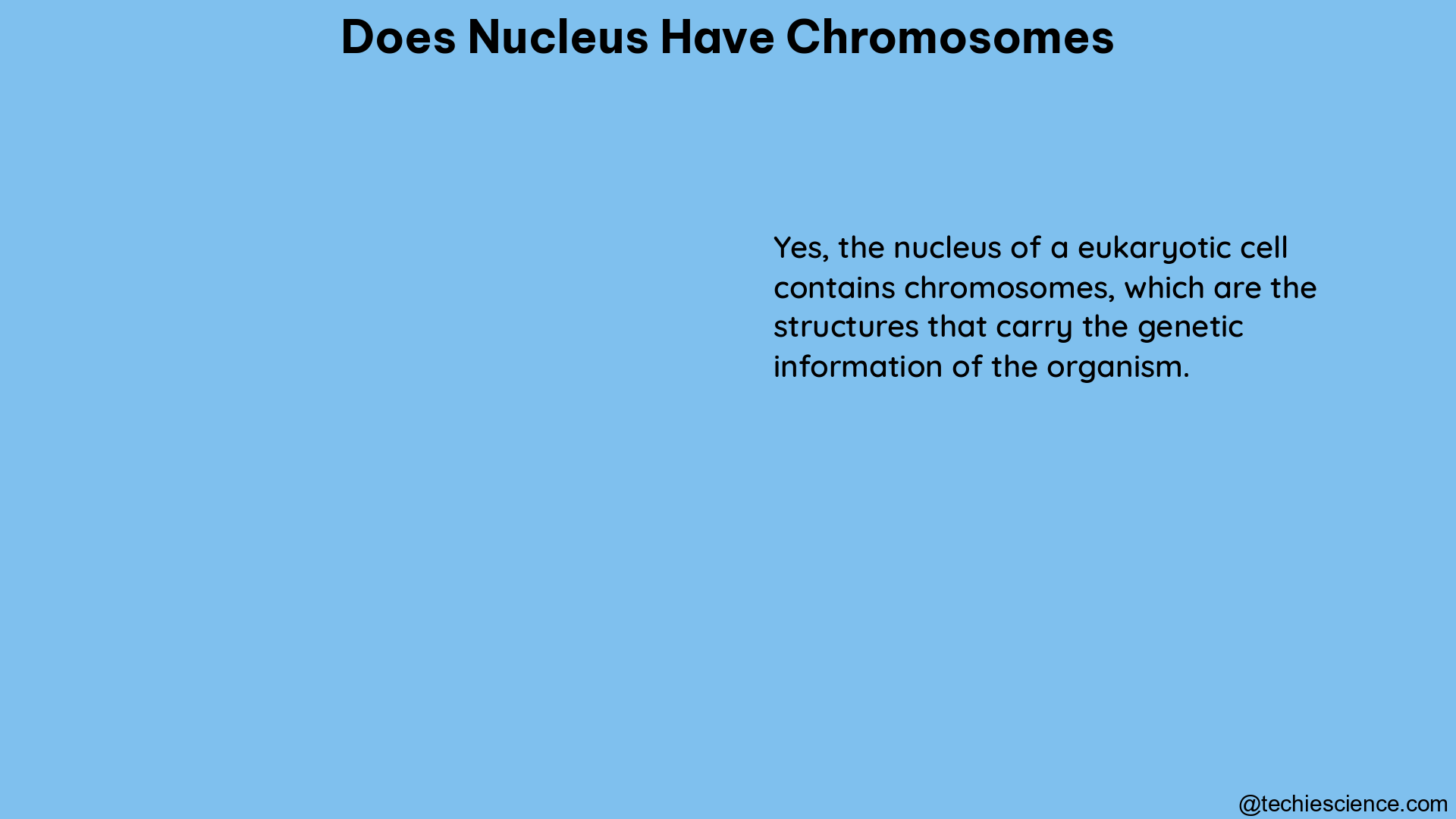The nucleus of a eukaryotic cell is the command center, housing the genetic material that dictates the cell’s functions and characteristics. At the heart of this genetic information are the chromosomes, which are thread-like structures composed of DNA and associated proteins. Understanding the relationship between the nucleus and chromosomes is crucial for comprehending the fundamental processes of life.
The Presence of Chromosomes in the Nucleus
The nucleus of a eukaryotic cell, such as those found in plants, animals, and fungi, contains chromosomes. These chromosomes are the carriers of genetic information, with each chromosome containing a single, long molecule of DNA. The number of chromosomes varies among different species, with humans having 46 chromosomes organized into 23 pairs.
During the cell cycle, chromosomes exhibit distinct behaviors:
-
Interphase: During the majority of the cell cycle, known as interphase, the chromosomes are not visible as distinct structures within the nucleus. Instead, the DNA is dispersed and associated with various proteins, forming a complex called chromatin.
-
Mitosis: When the cell is preparing to divide, the cell enters the mitotic phase of the cell cycle. During this phase, the chromosomes condense and become visible as distinct, rod-like structures. This condensation process is essential for the accurate segregation of the genetic material into the two daughter cells during cell division.
The number of chromosomes in a cell is a defining characteristic of a species. Humans, for example, have 46 chromosomes, organized into 23 pairs. This number is consistent across all the cells in the human body, with the exception of gametes (sperm and eggs), which have 23 chromosomes each.
Chromosome Organization within the Nucleus

Chromosomes are not randomly distributed within the nucleus. Instead, they occupy specific subdomains called “chromosome territories.” These territories are distinct regions within the nucleus where individual chromosomes are localized and organized.
The arrangement of chromosome territories can vary between different cell types and can influence gene expression. Techniques such as fluorescence in situ hybridization (FISH) have been used to visualize and study the organization of chromosome territories within the nucleus.
The factors that contribute to the organization of chromosomes within the nucleus are complex and multifaceted. They include:
-
Cell Cycle: The stage of the cell cycle can significantly impact the organization of chromosomes. During mitosis, for example, the chromosomes undergo dramatic changes in their structure and positioning within the nucleus.
-
Gene Expression: The expression of genes can influence the spatial arrangement of chromosomes within the nucleus. Actively transcribed genes tend to be located in more accessible regions of the nucleus, while silenced genes may be positioned in more compact, heterochromatic regions.
-
Physical Properties: The physical properties of chromosomes, such as their size, shape, and flexibility, can also play a role in their organization within the nucleus.
Chromosome Topology and Genome Function
The study of chromosome organization, also known as chromosome topology, is an active area of research in the field of molecular biology. Understanding the spatial arrangement of chromosomes within the nucleus has important implications for our understanding of genome function and disease.
Chromosome topology can influence various cellular processes, including:
-
Gene Expression: The positioning of chromosomes and specific genomic regions within the nucleus can affect the accessibility of genes to the transcriptional machinery, thereby influencing gene expression patterns.
-
DNA Repair: The organization of chromosomes can impact the efficiency of DNA repair mechanisms, as the spatial proximity of different genomic regions can facilitate or hinder the repair process.
-
Chromosome Segregation: The proper organization of chromosomes during cell division is crucial for ensuring the accurate segregation of genetic material into the daughter cells.
-
Epigenetic Regulation: The spatial arrangement of chromosomes can contribute to the establishment and maintenance of epigenetic modifications, which can have long-lasting effects on gene expression and cellular function.
Disruptions in chromosome topology have been associated with various human diseases, including cancer, developmental disorders, and neurodegenerative diseases. Understanding the complex interplay between chromosome organization and genome function is an area of ongoing research, with the potential to provide insights into the underlying mechanisms of these diseases and inform the development of targeted therapies.
Conclusion
In summary, the nucleus of a eukaryotic cell is the central hub that houses the genetic material, including the chromosomes. Chromosomes are the thread-like structures composed of DNA and associated proteins, and they play a crucial role in the storage and transmission of genetic information. The organization of chromosomes within the nucleus is a dynamic and complex process that is influenced by various factors, including the cell cycle, gene expression, and the physical properties of the chromosomes themselves. The study of chromosome topology is an active area of research, with important implications for our understanding of genome function and disease.
References:
- Cell Nucleus DNA – an overview | ScienceDirect Topics: https://www.sciencedirect.com/topics/nursing-and-health-professions/cell-nucleus-dna
- Chromosome Territories | Learn Science at Scitable – Nature: https://www.nature.com/scitable/topicpage/chromosome-territories-the-arrangement-of-chromosomes-in-3025/
- What’s the Link Between Chromosome Topology & Gene Expression?: https://www.activemotif.com/blog-chromosome-topology-gene-expression
- Nuclear morphologies: their diversity and functional relevance – NCBI: https://www.ncbi.nlm.nih.gov/pmc/articles/PMC5371643/
- Minute to Understanding: What is a chromosome?: https://www.jax.org/news-and-insights/minute-to-understanding/what-is-a-chromosome

Hi, I am Saif Ali. I obtained my Master’s degree in Microbiology and have one year of research experience in water microbiology from National Institute of Hydrology, Roorkee. Antibiotic resistant microorganisms and soil bacteria, particularly PGPR, are my areas of interest and expertise. Currently, I’m focused on developing antibiotic alternatives. I’m always trying to discover new things from my surroundings. My goal is to provide readers with easy-to-understand microbiology articles.
If you have a bug, treat it with caution and avoid using antibiotics to combat SUPERBUGS.
Let’s connect via LinkedIn: